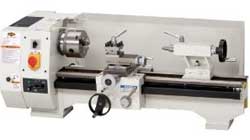| |
| Chapter I |
| THE ENGINE LATHE—TURNING AND BORING OPERATIONS |
| General Description of an Engine Lathe—Example of Cylindrical Turning—Facing the Ends Square with a Side-tool—Turning Tool—Turning
Work Cylindrical—Roughing and Finishing Cuts—Filing and
Finishing—Aligning Centers for Cylindrical Turning—Application of
Drivers or Dogs—Lathe Arbors or Mandrels—Different Types of Lathe
Arbors—Mandrel or Arbor Press—Steadyrest for Supporting Flexible
Parts—Application of Steadyrest when Boring—The Follow-rest—Centering
Parts to be Turned—Centering Machine—Different Forms of
Centers—Precaution When Centering Tool Steel—Facing the Ends of Centered
Stock—Truing Lathe Centers—Universal, Independent and Combination
Chucks—Application of Chucks—Example of Boring—Measuring Bored
Holes—Setting Work in the Chuck—Inaccuracy from Pressure of Chuck
Jaws—Drilling and Reaming—Holding Work on Faceplate—Application of
Angle-plate to Faceplate—Supporting Outer End of Chucked Work—Boring
Large Castings in the Lathe—Boring Holes to a Given Center
Distance—Turning Brass, Bronze and Copper—Machining Aluminum |
| |
| Chapter II |
| LATHE TURNING TOOLS AND CUTTING SPEEDS |
| Turning Tools for General Work—Tool-holders with
Inserted Cutters—The Position of Turning Tools—Tool Grinding—Shape or
Contour of Cutting Edge—Direction of Top Slope for Turning
Tools—Clearance for the Cutting Edge—Angle of Tool-point and Amount of
Top Slope—Grinding a Lathe Tool—Cutting Speeds and Feeds—Average Cutting
Speeds for Turning—Factors which Limit the Cutting Speed—Rules for
Calculating Cutting Speeds—Feed of Tool and Depth of Cut—Effect of
Lubricant on Cutting Speed—Lubricants Used for Turning—Lard Oil as a
Cutting Lubricant |
| |
| Chapter III |
| TAPER TURNING—SPECIAL OPERATIONS—FITTING |
| Setting Tailstock Center for Taper Turning—Example
of Taper Turning—Setting the Tailstock Center with a Caliper
Tool—Setting the Tailstock Center with a Square—The Taper
Attachment—Application of Taper Attachment—Height of Tool when Turning
Tapers—Taper Turning with the Compound Rest—Accurate Measurement of
Angles and Tapers—To Find Center Distance for a Given Taper—To Find
Center Distance for a Given Angle—To Find Angle for Given Taper per
Foot—To Find Angle for Given Disk Dimensions—Use of the Center
Indicator—Locating Work by the Button Method—Eccentric Turning—Turning a
Crankshaft in a Lathe—Special Crankshaft Lathe—Operation of Special
Crankshaft Lathe—Spherical Turning—Spherical Turning Attachments—Turning
with Front and Rear Tools—A Multiple-tool Lathe—Examples of Multiple
Turning—Knurling in the Lathe—Relieving Attachment—Application of
Relieving Attachment—Relieving Hobs or Taps Having Spiral Flutes—Classes
of Fits Used in Machine Construction—Forced Fits—Allowance for Forced
Fits—Pressure for Forced Fits—Allowance for Given Pressure—Shrinkage
Fits |
| |
|
| Chapter IV |
| THREAD CUTTING IN THE LATHE |
| Selecting the Change Gears for Thread Cutting—The
Thread Tool—Cutting the Thread—Indicator or Chasing Dial for Catching
Threads—Principle of the Thread Indicator—Replacing Sharpened Thread
Tool—Use of Compound Rest for Thread Cutting—Threads Commonly
Used—Multiple Threads—Cutting a U. S. Standard Thread—Cutting a
Left-hand Thread—Cutting a Square Thread—Cutting Multiple
Threads—Setting Tool When Cutting Multiple Threads—Taper
Threading—Internal Threading—Stop for Thread Tools—The Acme Standard
Thread—The Whitworth Thread—Worm Threads—Coarse Threading
Attachment—Testing the Size of a Thread—The Thread Micrometer—Three-wire
System of Measuring Threads—Rivett-Dock Threading Tool—Cutting Screws
to Compensate for Shrinkage—Calculating Change Gears for Thread
Cutting—Lathes with Compound Gearing—Fractional Threads—Change Gears for
Metric Pitches—Quick Change-gear Type of Lathe |
| |
| Chapter V |
| TURRET LATHE PRACTICE |
| General Description of a Turret Lathe—Example of
Turret Lathe Work—Machining Flywheels in Turret Lathe—Finishing a
Flywheel at One Setting in Turret Lathe—Finishing a Webbed Flywheel in
Two Settings—Tools for Turret Lathes—Box-tools—Examples of Box-tool
Turning—Hollow Mills—Releasing Die and Tap Holders—Self-opening Die
Heads—Collapsing Taps—Miscellaneous Turret Lathe Tools—Turning Gasoline
Engine Pistons in Turret Lathe—Turning Piston Rings in Turret
Lathe—Piston Turning in Pratt and Whitney Turret Lathe—Attachment for
Turning Piston Rings—Turning Worm-gear Blanks in Turret Lathe—Turning
Bevel Gear Blanks—Shell Turning Operation in Flat Turret Lathe—Chuck
Work in Flat Turret Lathe—Double-spindle Flat Turret Lathe—Automatic
Chucking and Turning Machine—Example of Work on Automatic Turning
Machine—Determining Speed and Feed Changes—Setting the Turret
Slide—Setting the Cross-slide Cam—Setting the Boring Tool for
Recessing—Adjustments for Automatic Feed and Speed Changes—Turning
Flywheel in Automatic Chucking and Turning Machine—Automatic
Multiple-spindle Chucking Machine—Selecting Type of Turning Machine |
| |
| Chapter VI |
| VERTICAL BORING MILL PRACTICE |
| Boring and Turning in a Vertical Boring Mill—Holding
and Setting Work on Boring Mill Table—Turning in a Boring Mill—Boring
Operations—Turning Tools for the Vertical Boring Mill—Turning a Flywheel
on a Vertical Mill—Convex Turning Attachment for Boring Mills—Turning
Taper or Conical Surfaces—Turret-lathe Type of Vertical Boring
Mill—Examples of Vertical Turret Lathe Work—Floating Reamer
Holders—Multiple Cylinder Boring Machine |
| |
| Chapter VII |
| HORIZONTAL BORING MACHINES |
Horizontal Boring Machine with Vertical Table Adjustment—Drilling and Boring—Cutters
Used—Cutter-heads for Boring Large Holes—Cylinder Boring—Boring a
Duplex Gasoline Engine Cylinder—Examples of Boring, Radial Facing and
Milling—Fixture for Cylinder Lining or Bushing—Horizontal Boring Machine
of Floor Type |
| |
|


